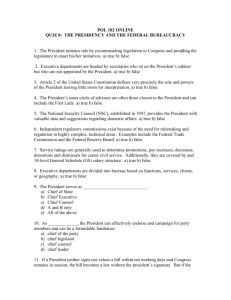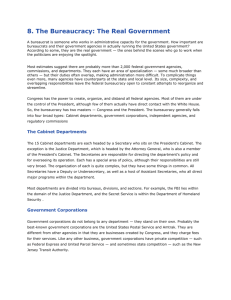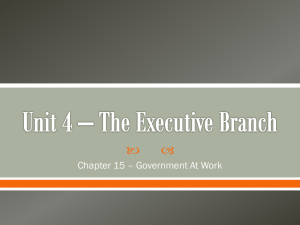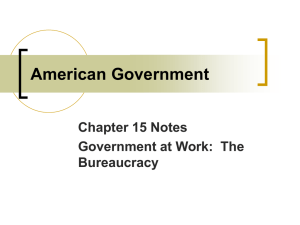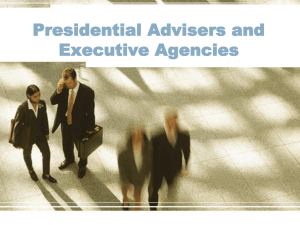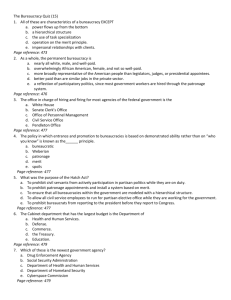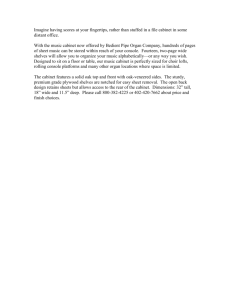Chapter 14: The Bureaucracy
advertisement
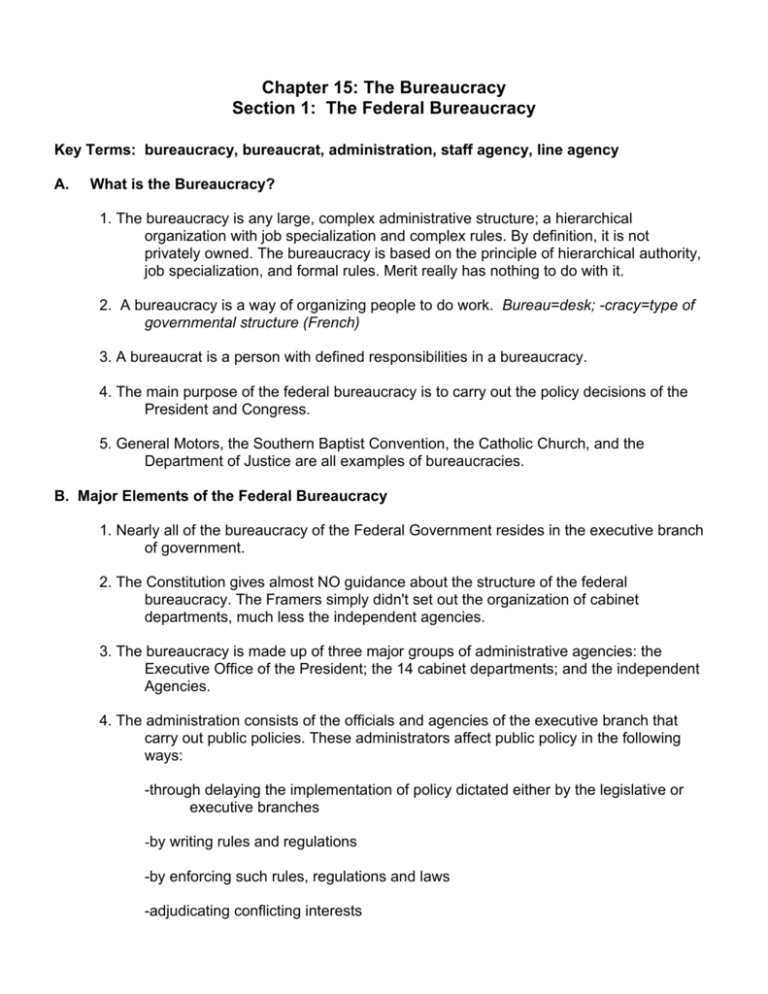
Chapter 15: The Bureaucracy Section 1: The Federal Bureaucracy Key Terms: bureaucracy, bureaucrat, administration, staff agency, line agency A. What is the Bureaucracy? 1. The bureaucracy is any large, complex administrative structure; a hierarchical organization with job specialization and complex rules. By definition, it is not privately owned. The bureaucracy is based on the principle of hierarchical authority, job specialization, and formal rules. Merit really has nothing to do with it. 2. A bureaucracy is a way of organizing people to do work. Bureau=desk; -cracy=type of governmental structure (French) 3. A bureaucrat is a person with defined responsibilities in a bureaucracy. 4. The main purpose of the federal bureaucracy is to carry out the policy decisions of the President and Congress. 5. General Motors, the Southern Baptist Convention, the Catholic Church, and the Department of Justice are all examples of bureaucracies. B. Major Elements of the Federal Bureaucracy 1. Nearly all of the bureaucracy of the Federal Government resides in the executive branch of government. 2. The Constitution gives almost NO guidance about the structure of the federal bureaucracy. The Framers simply didn't set out the organization of cabinet departments, much less the independent agencies. 3. The bureaucracy is made up of three major groups of administrative agencies: the Executive Office of the President; the 14 cabinet departments; and the independent Agencies. 4. The administration consists of the officials and agencies of the executive branch that carry out public policies. These administrators affect public policy in the following ways: -through delaying the implementation of policy dictated either by the legislative or executive branches -by writing rules and regulations -by enforcing such rules, regulations and laws -adjudicating conflicting interests C. The Name Game 1. The term "department" is reserved for agencies of cabinet rank 2. The terms "administration" or "agency" are used to refer to any governmental body or, more particularly, to a major unit headed by a single administrator of near-cabinet rank. The terms agency and administration are used interchangeably. 3. The term "commission" is reserved for agencies charged with the regulation of business activities. Commissions are headed by varying numbers of top-ranking officers, or commissioners. 4. The terms "corporation" and "authority" are used for agencies that have a board and a manager and that is designed to conduct business-like activities. 5. While the above terms have precise definition, they are are not used consistently. There is little uniformity in the use of terms describing units within the executive branch and the lines are now blurred. D. Staff and Line Agencies 1. Staff agencies are those agencies that serve in a support capacity by furnishing advice and assistance in the management of an organization. Examples: The White House Office; National Security Council. 2. Line agencies are those agencies that actually perform the tasks for which the organization exists. Examples: The Department of State, Department of Justice, and The Environmental Protection Agency. Chapter 15: The Bureaucracy Section 2: The Executive Office of the President Key Terms: Executive Office of the President, federal budget, fiscal year, domestic affairs A. The Executive Office of the President 1. The Executive Office of the President, also known generally as the "White House Staff," is an umbrella agency made up of several separate offices and staffed by the President's closest advisors and assistants. 2. It includes the chief of staff, the counsel to the President, the press secretary, and expert advisers in many areas. B. The White House Office 1. This is the nerve-center of the White House. It houses the President’s key and personal staff. 2. The White House Office is located in the West Wing of the White House. 3. The President’s Chief-of-Staff directs all of the White House Staff from this office. 4. Also located in this office are the press secretary, the President’s counsel, and the Presidential doctor. 5. About 400 people work directly for the President from this office. C. The National Security Council 1. The NSC advises the President on matters of national security, foreign and domestic. 2. Its members include the Vice President, the secretaries of state and defense, the director of the CIA, and the chairperson of the Joint Chiefs of Staff. D. The Office of Management and Budget (OMB) 1. The OMB is a powerful agency whose major task is to help the President coordinate legislative and budgetary proposals from the executive branch. 2. It also monitors the spending of funds appropriated by Congress and oversees the management of the executive branch. E. The Office of National Drug Control Policy 1. The Office of National Drug Control Policy prepares an annual drug control policy. 2. It coordinates the efforts of more than 50 federal agencies involved in the "War on Drugs." F. The Council of Economic Advisors 1. The Council of Economic Advisors consists of three top economists, appointed by the President and approved by the Senate. These three advisors CANNOT be removed by the President at will. 2. It is the President's chief source of information and advice on the economy. Chapter 15: The Bureaucracy Section 3: The Executive Departments Key Terms: executive departments, secretary, attorney general A. Executive Departments 1. Much of the work of the Federal Government is done by the 15 executive departments. They are often called the Cabinet Departments and are each is built around some broad field of activity. 2. The 1st Congress created the 1st 3 departments in 1789: State, Treasury, & War. The newest department, the Department of Homeland Security, was created in 2003. 3. Chief Officers and Staff -Each department is headed by a secretary, except for the Department of Justice, which is headed by the Attorney General. Each secretary is also a member of the President’s cabinet. -Each department head is the primary link between presidential policy and their department. They also advocate for their department and its policies with the President. -Each department head is appointed by the President and confirmed by the Senate B. The Cabinet 1. The President appoints cabinet members, who must be confirmed by the Senate. The President may remove cabinet members without Senate approval. 2. Many factors, both political and substantive, influence the selection of cabinet officials. -Until recently, most cabinet members have been white males. -Very few women and members of minority groups have been cabinet members in this century. -Bill Clinton appointed more women and minorities to cabinet positions than any other President. 3. Each cabinet member heads one of the executive departments, and, together, cabinet members serve as advisors to the President. 4. President’s vary in how much they use the cabinet in their role as advisors. There is no Constitutional requirement to have a cabinet, but there has never been a move to eliminate the cabinet, even though some Presidents tend not to use the cabinet very much. Chapter 15: The Bureaucracy Section 4: Independent Agencies Key Terms: independent agencies, independent executive agencies, independent regulatory commissions, quasi-legislative, quasi-judicial, government corporation A. What are Independent Agencies? 1. An independent agency (often "mis-referred to as an "independent executive agency") is an agency created by Congress and which operates outside the 15 executive departments in the cabinet. 2. While often referred to as "independent executive agencies," these agencies, as noted above, operate outside the executive departments (cabinet), but are nonetheless considered part of the executive branch of government. 3. There are four major reasons that explain why these independent agencies exist outside of the cabinet department structure. -Some agencies are independent because their functions did not fit well into any of the existing departments. -Some are independent to protect their officials from political pressures. -Some are independent to make them more responsive to interest-group pressures. -Some are independent because of the peculiar and sensitive nature of their functions. 4. There are three types of independent agencies: independent executive agencies, independent regulatory commissions, and government corporations. The Office of Personnel Management, the Peace Corps and the Civil Rights Commission are examples of independent executive agencies which are "supposed" to be free from political influence. 5. Contrast an independent executive agency with a executive department, such as the Department of Labor that was created largely to give representation in government to labor unions, or the Department of Veterans' Affairs, which represents the interests of military veterans, both of which are important groups in American politics. B. The Independent Executive Agencies 1. Most of the independent agencies fall into this category. Examples of independent executive agencies are the Civil Rights Commission and the Peace Corps. 2. They are organized under a single administrator and have subunits that operate on a regional basis. C. The Independent Regulatory Commissions (Agencies) 1. These commissions are created to regulate important aspects of the nation's economy. 2. Independent regulatory commissions are quasi-legislative bodies that operate largely outside presidential control. -The members of the commissions are appointed by the President and are approved by the Senate for long, staggered terms. Heads of the independent regulatory commissions CANNOT be removed by the President at will. -Members of independent regulatory commissions (agencies) often have extensive experience working in the industry that they regulate while on the commission. Independent regulatory commissions (agencies) are said to be "captured" when it serves to unduly protect the interests of the industry it regulates, rather than the public interest. -These boards and commissions must be made up of members of both parties, and members cannot be removed for political reasons. Terms are most often long and staggered. 3. Independent regulatory commissions have quasi-legislative and quasi-judicial powers. -quasi-legislative powers are used in rule making and regulatory functions and have the force of law -quasi-judicial powers are exercised when disputes are decided in those fields in which Congress has given policing authority, i.e., Interstate Commerce Commission 4. These regulatory bodies possess all three powers - executive, legislative, and judicial and are exceptions to the principle of separation of powers. 5. The power of the regulatory commissions is controversial and has been decreased under Presidents Reagan and Bush. [They believed in a weaker federal government. 6. Congress has attempted to protect independent regulatory agencies from political influence by requiring that each agency be led by a group of commissioners representing both major political parties. D. The Government Corporations 1. Government corporations provide a service that can be readily handled by the private sector. These corporations are within the executive branch, and they are under the control of the President. 2. Their top officers are appointed by the President with Senate confirmation; all of their employees are public officials. The Postal Service and the Tennessee Valley Authority are examples of government corporations. 3. Some controversy exists as to whether government corporations are compatible with the democratic government's requirement that all public agencies be accountable to the public. Nonetheless, the advantage most often claimed for the use of government corporations is their flexibility. Chapter 15: The Bureaucracy Section 5: The Civil Service Key Terms: civil service, spoils system, patronage, register, bipartisan A. Development of the Civil Service 1. The Constitution says very little about staffing the Federal Bureaucracy 2. Washington said you should choose the best qualified, but tended to pick members of his own party, the Federalists. 3. When Jefferson took over in 1801, he replaced most of the Federalists in the government with people from his own party, the Democratic-Republicans. 4. Until about 100 years ago, a person got a job with the government through the spoils system (a hiring and promotion system based on knowing the right people). This is also called patronage: The practice of giving government jobs to the President's friends and political supporters. 5. The spoils system was largely defended by President Jackson who believed that the largest number of citizens should have the privilege of serving in government office, that any person of "normal" intelligence was fit to hold any government position, and that all government officials should belong to the party elected by the people. 6. Support for a civil service system increased dramatically as a result of the assassination of President Garfield in 1881. The Pendleton Act of 1883 created a system in which federal employees were chosen on the basis of competitive examinations, thus making merit, or ability, the reason for hiring people to fill federal positions. 7. President Jimmy Carter improved the system when he urged Congress to pass the Civil Service Reform Act of 1978. Reforms included the creation of the Office of Personnel Management (OPM), the federal agency which is charged with the testing and hiring of most federal workers. (Persons who pass civil service exams are placed on a "register" kept by OPM), and the Merit System Protection Board which enforces the merit system in the federal bureaucracy. Consequently, today, most federal agencies are covered by some sort of civil service system, based on the merit principle. B. The Civil Service Today 1. A civil servant is an employee of the federal government who has been hired on the basis of merit, rather than political affiliation. There are approximately three million civil servants (17 million if state and local public employees are included) in government. 2. Creating a non-partisan civil service meant insulating government workers from the risk of being fired when a new party comes to power. 3. Salaries are proposed by the Civil Service System, subject to congressional appropriations. In general, at lower and middle levels, the federal pay scale is comparable to that found in the private sector, but at higher levels, it is significantly lower. For example, blue collar workers in the federal civil system are generally paid the same as blue collar workers in the private sector. On the other hand, the Secretary of Transportation is paid significantly lower than the CEO of General Motors. Congress does not control the salary of postal workers. C. Political Activities 1. The Hatch Act (1939, amended 1993) prohibits civil servants from active participation in partisan politics. Under the terms of the Hatch Act, civil servants are permitted to: -Vote in primary elections -Contribute money to a political party -Attend a political rally -Place a bumper sticker on their personal property -PRIOR to the 1993 amendments, civil servants were prohibited from coordinating a campaign for a neighbor running for political office. Iron Triangles A. Presidents and Congress have difficulty in controlling bureaucracies due to the existence of "iron triangles." B. When agencies, groups, and committees all depend on one another and are in close, frequent, "cozy" contact, they form "iron triangles" or sub-governments. C. Iron triangles are composed of bureaucratic agencies, interest groups, and congressional committees. The iron triangle is characterized by mutual dependency, in which each element provides key services, information, or policy for the others. D. The concept is currently best illustrated by the tobacco triangle, where a congressional committee, an bureaucratic (executive) agency, and an interest group, i.e., the tobacco interests, all inform and stroke each other to further their survival.

